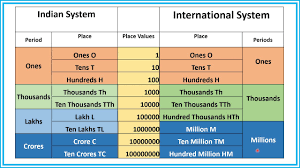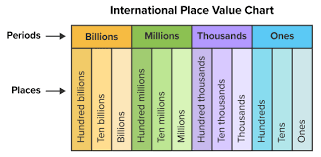
International Numeral System: A long time ago, people didn’t have numbers. They used sticks, pebbles, or marks on rocks to count things like animals or food.
Over time, people invented numbers and created number systems to organize and write them clearly. Different countries developed their own systems, and today, two of the most common ones are the Indian numeral system and the International Numeral System. The Indian numeral system is mainly used in India. It divides numbers into groups called periods, like lakhs and crores. For example, the number 12345678 is written as 1,23,45,678 and read as "One crore, twenty-three lakh, forty-five thousand, six hundred seventy-eight." International Numeral System, used worldwide, divides numbers differently and uses terms like millions and billions. For example, the same number is written as 12,345,678 and read as "Twelve million, three hundred forty-five thousand, six hundred seventy-eight." In this blog, we’ll explore how the International Numeral System works , compare it to the Indian Numeral System , and see how it helps make numbers easier to read and understand.What is International Numeral System?
International Numeral System is a globally recognized method for representing large numbers. In this number system, digits are grouped into periods of three, separated by commas, starting from the right. The primary periods are Ones, Thousands, Millions, and Billions. Each digit's place value is determined by its position within these periods. For instance, in 12,345,678, the digit '1' is in the Ten Million place, '2' in the Million place, '3' in the Hundred Thousand place, and so forth. This positional structure allows for a clear understanding of each digit's value. The system also defines specific relationships between place values:- 1 hundred = 10 tens (Example: 100 = 10 × 10)
- 1 thousand = 10 hundreds = 100 tens (Example: 1,000 = 10 × 100)
- 1 million = 1,000 thousand (Example: 1,000,000 = 1,000 × 1,000)
- 1 billion = 1,000 millions (Example: 1,000,000,000 = 1,000 × 1,000,000)
International Numeral System Place Value Chart
International Numeral System Place Value Chart is a tool that helps to clearly understand how digits in a number are grouped into periods and assigned specific values based on their position. Each digit's place in the International Numeral chart determines its place value, which signifies its contribution to the overall number.How to Use the International Numeral System Place Value Chart?
The steps to use the International Numeral System Place Value Chart are discussed below : Step 1: Start by dividing the number into groups of three digits from right to left. Each group represents a specific period, such as Ones, Thousands, Millions, and so on. Commas are used to separate these groups for clarity. To understand this better, let’s take the number 85,419,723 and break it into groups of three digits from right to left:- The first group from the right is 723, which belongs to the Ones period.
- The second group is 419, which belongs to the Thousands period.
- The third group is 85, which belongs to the Millions period.
- 8 is in the Tens place, representing 80 million.
- 5 is in the Ones place, representing 5 million.
- 4 is in the Hundreds place, representing 400 thousand.
- 1 is in the Tens place, representing 10 thousand.
- 9 is in the Ones place, representing 9 thousand.
- 7 is in the Hundreds place, representing 700.
- 2 is in the Tens place, representing 20.
- 3 is in the Ones place, representing 3.
- The Millions period contains 85, which means "Eighty-five million."
- The Thousands period contains 419, which means "Four hundred nineteen thousand."
- The Ones period contains 723, which means "Seven hundred twenty-three."
| Ten-Million | Million | Hundred Thousand | Ten Thousand | Thousands | Hundreds | Tens | Ones |
| 8 | 5 | 4 | 1 | 9 | 7 | 2 | 3 |
International Number System Rules
The International Number System follows specific rules to ensure clarity and uniformity in writing and reading numbers. Below are the key guidelines of International Number System:Correct Use of Period Names:
Period names are never written in plural form. For example, 456,876 is written as four hundred fifty-six thousand eight hundred seventy-six, not four hundred fifty-six thousands or hundreds.Avoiding 'And' Before Tens and Ones:
The word 'and' is not used when reading numbers before the tens or one's place. For example, 3535 is read as three thousand five hundred thirty-five, not three thousand and five hundred thirty-five.No Commas in Expanded Form:
When writing numbers in expanded form, commas are not included. For instance, 3535 is written as three thousand five hundred thirty-five, not three thousand, five hundred thirty-five. By adhering to these rules, the International Number System ensures consistency and avoids confusion when interpreting numerical values.Difference Between the Indian and International Number Systems
The Indian and International Number Systems organize numbers into periods based on their place values, but they differ in grouping and naming conventions.
Grouping of Digits
Indian Number System: Starting from the right, the first period contains 3 digits, while all subsequent periods contain 2 digits. Example: 23,45,678 is grouped as 23 (Lakh), 45 (Thousand), 678 (Ones). International Number System: Starting from the right, all periods contain 3 digits . Example: 2,345,678 is grouped as 2 (Million), 345 (Thousand), 678 (Ones).Place Value Names
Indian Number System: Place values are named as Ones, Tens, Hundreds, Thousands, Ten Thousand, Lakhs, Ten Lakhs, Crores, Ten Crores, and so on. International Number System: Place values are named as Ones, Tens, Hundreds, Thousands, Ten Thousand, Hundred Thousand, Millions, Ten Million, Hundred Million, and so on.Units Used
Indian Number System: Uses Lakhs and Crores for large numbers. Example: 1,00,000 is called One Lakh, and 1,00,00,000 is called One Crore. International Number System: Uses Millions and Billions for large numbers. Example : 100,000 is called One Hundred Thousand, and 1,000,000 is called One Million.International Number System Examples
Example 1: Rewrite the number 29384756 in the international numeral system.
Solution: In the International numeral system, digits are grouped in sets of three, starting from the right.- Group the digits: 29,384,756
- Read the number: Twenty-nine million, three hundred eighty-four thousand, seven hundred fifty-six.
- In the number 40,324,056, the first 4 is in the ten million place, and its place value is 40,000,000.
- The second 4 is in the thousands place, and its place value is 4,000.
- Difference: 40,000,000 - 4,000 = 39,996,000.
- Using 3 and 5, numbers are 35 and 53.
- Using 3 and 6, numbers are 36 and 63.
- Using 5 and 6, numbers are 56 and 65.
- Arrange digits in ascending order to get the smallest number: 1,467.
- Arrange digits in descending order to get the largest number: 7,641.
- Ones period: 523
- Thousands period: 874
- Ones period: 523
- Thousands period: 874
| Related Articles | |
| Corresponding Angles | Isosceles Triangle |
| Average Speed Formula | Differentiation |
| Ratio | Surface Area of Cylinder |
International Numeral System FAQs
What is the difference between the periods in the Indian and International Number Systems?
In the Indian system, the first period has three digits, and subsequent periods have two digits. In the International system, all periods have three d
Why are commas used in the International Number System?
Commas are used to separate digits into groups of three, called periods, to make large numbers easier to read and interpret.
Write the number 1,205,000 in expanded form.
1,205,000 in expanded form is 1,000,000 + 200,000 + 5,000.
What is the difference between one million and one billion?
One million: 1,000,000 (6 zeros).
One billion: 1,000,000,000 (9 zeros).
The difference is 999,000,000.
Talk to a counsellorHave doubts? Our support team will be happy to assist you!

Free Learning Resources
PW Books
Notes (Class 10-12)
PW Study Materials
Notes (Class 6-9)
Ncert Solutions
Govt Exams
Class 6th to 12th Online Courses
Govt Job Exams Courses
UPSC Coaching
Defence Exam Coaching
Gate Exam Coaching
Other Exams
Know about Physics Wallah
Physics Wallah is an Indian edtech platform that provides accessible & comprehensive learning experiences to students from Class 6th to postgraduate level. We also provide extensive NCERT solutions, sample paper, NEET, JEE Mains, BITSAT previous year papers & more such resources to students. Physics Wallah also caters to over 3.5 million registered students and over 78 lakh+ Youtube subscribers with 4.8 rating on its app.
We Stand Out because
We provide students with intensive courses with India’s qualified & experienced faculties & mentors. PW strives to make the learning experience comprehensive and accessible for students of all sections of society. We believe in empowering every single student who couldn't dream of a good career in engineering and medical field earlier.
Our Key Focus Areas
Physics Wallah's main focus is to make the learning experience as economical as possible for all students. With our affordable courses like Lakshya, Udaan and Arjuna and many others, we have been able to provide a platform for lakhs of aspirants. From providing Chemistry, Maths, Physics formula to giving e-books of eminent authors like RD Sharma, RS Aggarwal and Lakhmir Singh, PW focuses on every single student's need for preparation.
What Makes Us Different
Physics Wallah strives to develop a comprehensive pedagogical structure for students, where they get a state-of-the-art learning experience with study material and resources. Apart from catering students preparing for JEE Mains and NEET, PW also provides study material for each state board like Uttar Pradesh, Bihar, and others
Copyright © 2025 Physicswallah Limited All rights reserved.
Get App









